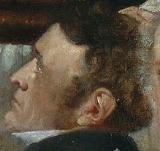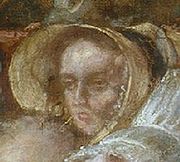
John Harfield Tredgold
Encyclopedia
John Harfield Tredgold was an English chemist in the Cape Colony
in Africa. He held a number of voluntary roles including Secretary of the British and Foreign Anti-Slavery Society. The suburb of Cape Town called Harfield drew its name from Tredgold's middle name.
He arrived in the Cape
in 1818 (possibly 24 June 1818) and was licensed on 3 July 1818 as a chemist and druggist in the colony. He became a partner in the pharmacy Thredgold and Pocock.
Tredgold married Elizabeth Merrington in Cape Town
on New Year's Day 1825 in St Georges Cathedral
before it was rebuilt. Elizabeth was born in London in December 1806.
Tredgold was a member of the Cape of Good Hope Philanthropic Society and worked with those in poverty. He was one of the founders of the Commercial Exchange and helped to manage the Cape of Good Hope Savings Bank. He was a member of the influential Congregational Union Chapel in Cape Town who laboured for the emancipation of the slaves at the Cape.
He is thought to have employed John Pocock, whose diaries give an insight into the Tredgold's family life. Of particular note is a reference to an evening in 1836 when letters were read at a party from Richard Miles
, "a Bechuana boy formerly in the employ of Mr T. but now an itinerant preacher to the native tribes beyond the border".
" Richard Miles was to go on to have an interesting career as a preacher and interpreter long after Thredgold had left the country. In 1850, Richard Miles was appointed Kaptyn of Bethanie, by the British Resident, Major Warden, in the name of His Excellency the Governor of the Cape.
Tredgold and his family left the Cape on 19 February 1837 due to illness in the family (including his own). This may have been unplanned, as in the same year he was appointed to be a member of a committee authorised by the Governor of the Cape of Good Hope
, Lt-General Sir Benjamin d'Urban
. Those worthies chosen were to be members of the "Children's Friend Society" who were to liase with an organisation of the same name in London to safeguard "poor and destitute" children who were moved so that they might learn a trade.
 Tredgold and his wife Elizabeth attended the World's Anti-Slavery Society Convention on 12 June 1840. The picture above shows them in a painting made to commemorate the event, which attracted delegates from America, France, Haiti, Australia, Ireland, Jamaica and Barbados. Tredgold is shown at the centre of the painting in his role as secretary whilst Thomas Clarkson
Tredgold and his wife Elizabeth attended the World's Anti-Slavery Society Convention on 12 June 1840. The picture above shows them in a painting made to commemorate the event, which attracted delegates from America, France, Haiti, Australia, Ireland, Jamaica and Barbados. Tredgold is shown at the centre of the painting in his role as secretary whilst Thomas Clarkson
speaks. His wife is shown with most of the women to the right of the painting. It had been a matter of much debate as to where the female delegates would sit. Eventually the organisers had insisted that they sit with all the other women and male observers. A few women were included in the painting of the convention with Elizabeth Tredgold; these were Elizabeth Pease
, Amelia Opie
, Baroness Byron, Mary Anne Rawson
, Mrs John Beaumont, Thomas Clarkson
's daughter Mary and right at the back Lucretia Mott
.
After 1842 Elizabeth Tredgold returned to South Africa with five of her children. Two of her boys had died, aged thirteen and eleven, whilst they were in England. Mrs Tredgold died on 16 March 1892 at her daughter Elizabeth McIntyre's house in Ceres, Western Cape
.
Cape Colony
The Cape Colony, part of modern South Africa, was established by the Dutch East India Company in 1652, with the founding of Cape Town. It was subsequently occupied by the British in 1795 when the Netherlands were occupied by revolutionary France, so that the French revolutionaries could not take...
in Africa. He held a number of voluntary roles including Secretary of the British and Foreign Anti-Slavery Society. The suburb of Cape Town called Harfield drew its name from Tredgold's middle name.
Biography
Tredgold was baptised in 1798 by his parents Thomas and Elizabeth Tredgold. His middle name was his mother's surname before she married 10 April 1795.He arrived in the Cape
Cape Colony
The Cape Colony, part of modern South Africa, was established by the Dutch East India Company in 1652, with the founding of Cape Town. It was subsequently occupied by the British in 1795 when the Netherlands were occupied by revolutionary France, so that the French revolutionaries could not take...
in 1818 (possibly 24 June 1818) and was licensed on 3 July 1818 as a chemist and druggist in the colony. He became a partner in the pharmacy Thredgold and Pocock.
Tredgold married Elizabeth Merrington in Cape Town
Cape Town
Cape Town is the second-most populous city in South Africa, and the provincial capital and primate city of the Western Cape. As the seat of the National Parliament, it is also the legislative capital of the country. It forms part of the City of Cape Town metropolitan municipality...
on New Year's Day 1825 in St Georges Cathedral
St. George's Cathedral, Cape Town
St George's Cathedral is the Anglican cathedral in Cape Town, South Africa. It is the seat of the Archbishop of Cape Town....
before it was rebuilt. Elizabeth was born in London in December 1806.
Tredgold was a member of the Cape of Good Hope Philanthropic Society and worked with those in poverty. He was one of the founders of the Commercial Exchange and helped to manage the Cape of Good Hope Savings Bank. He was a member of the influential Congregational Union Chapel in Cape Town who laboured for the emancipation of the slaves at the Cape.
He is thought to have employed John Pocock, whose diaries give an insight into the Tredgold's family life. Of particular note is a reference to an evening in 1836 when letters were read at a party from Richard Miles
Richard Miles (Tswana catechist)
Richard Miles was a Motswana catechist and preacher "to the native tribes beyond the border" in South Africa.-Origins:Nothing definite is known of Richard Miles's origins, except that he was born a Motswana , and as a youth was in the employ of the apothecary John Harfield Tredgold in Cape...
, "a Bechuana boy formerly in the employ of Mr T. but now an itinerant preacher to the native tribes beyond the border".
" Richard Miles was to go on to have an interesting career as a preacher and interpreter long after Thredgold had left the country. In 1850, Richard Miles was appointed Kaptyn of Bethanie, by the British Resident, Major Warden, in the name of His Excellency the Governor of the Cape.
Tredgold and his family left the Cape on 19 February 1837 due to illness in the family (including his own). This may have been unplanned, as in the same year he was appointed to be a member of a committee authorised by the Governor of the Cape of Good Hope
Cape Colony
The Cape Colony, part of modern South Africa, was established by the Dutch East India Company in 1652, with the founding of Cape Town. It was subsequently occupied by the British in 1795 when the Netherlands were occupied by revolutionary France, so that the French revolutionaries could not take...
, Lt-General Sir Benjamin d'Urban
Benjamin d'Urban
Lieutenant-General Sir Benjamin d'Urban, GCB, KCH, KCTS was a British general and colonial administrator, who is best known for his frontier policy when he was the Governor in the Cape Colony .-Early career:...
. Those worthies chosen were to be members of the "Children's Friend Society" who were to liase with an organisation of the same name in London to safeguard "poor and destitute" children who were moved so that they might learn a trade.

Thomas Clarkson
Thomas Clarkson , was an English abolitionist, and a leading campaigner against the slave trade in the British Empire. He helped found The Society for Effecting the Abolition of the Slave Trade and helped achieve passage of the Slave Trade Act of 1807, which ended British trade in slaves...
speaks. His wife is shown with most of the women to the right of the painting. It had been a matter of much debate as to where the female delegates would sit. Eventually the organisers had insisted that they sit with all the other women and male observers. A few women were included in the painting of the convention with Elizabeth Tredgold; these were Elizabeth Pease
Elizabeth Pease Nichol
Elizabeth Pease Nichol was an abolitionist, anti-segregationist, woman suffragist, chartist and anti-vivisectionist in 19th century Great Britain. In 1853 she married Dr. John Pringle Nichol , Regius Professor of Astronomy at the University of Glasgow...
, Amelia Opie
Amelia Opie
Amelia Opie, née Alderson , was an English author who published numerous novels in the Romantic Period of the early 19th century, through 1828.-Life and work:...
, Baroness Byron, Mary Anne Rawson
Mary Anne Rawson
Mary Anne Rawson was an abolitionist. She was a campaingner with the Tract Society, the British and Foreign Bible Society, Italian nationalism, Child labour, but above all anti-slavery. She was first involved with a Sheffield group who successfully campaigned for people to boycott sugar from the...
, Mrs John Beaumont, Thomas Clarkson
Thomas Clarkson
Thomas Clarkson , was an English abolitionist, and a leading campaigner against the slave trade in the British Empire. He helped found The Society for Effecting the Abolition of the Slave Trade and helped achieve passage of the Slave Trade Act of 1807, which ended British trade in slaves...
's daughter Mary and right at the back Lucretia Mott
Lucretia Mott
Lucretia Coffin Mott was an American Quaker, abolitionist, social reformer, and proponent of women's rights.- Early life and education:...
.
After 1842 Elizabeth Tredgold returned to South Africa with five of her children. Two of her boys had died, aged thirteen and eleven, whilst they were in England. Mrs Tredgold died on 16 March 1892 at her daughter Elizabeth McIntyre's house in Ceres, Western Cape
Ceres, Western Cape
Ceres is a town with 46,251 inhabitants in the Western Cape Province of South Africa. It is the administrative centre and largest town of the Witzenberg Local Municipality. Ceres serves as a regional centre for the surrounding towns of Wolseley, Tulbagh, Op-die-Berg and Prince Alfred Hamlet...
.
Works
- Emigration to Jamaica: Why Should not Englishmen, Irishmen, and Scotchmen go to Jamaica. (London: British and Foreign Anti-Slavery Committee) 1841

